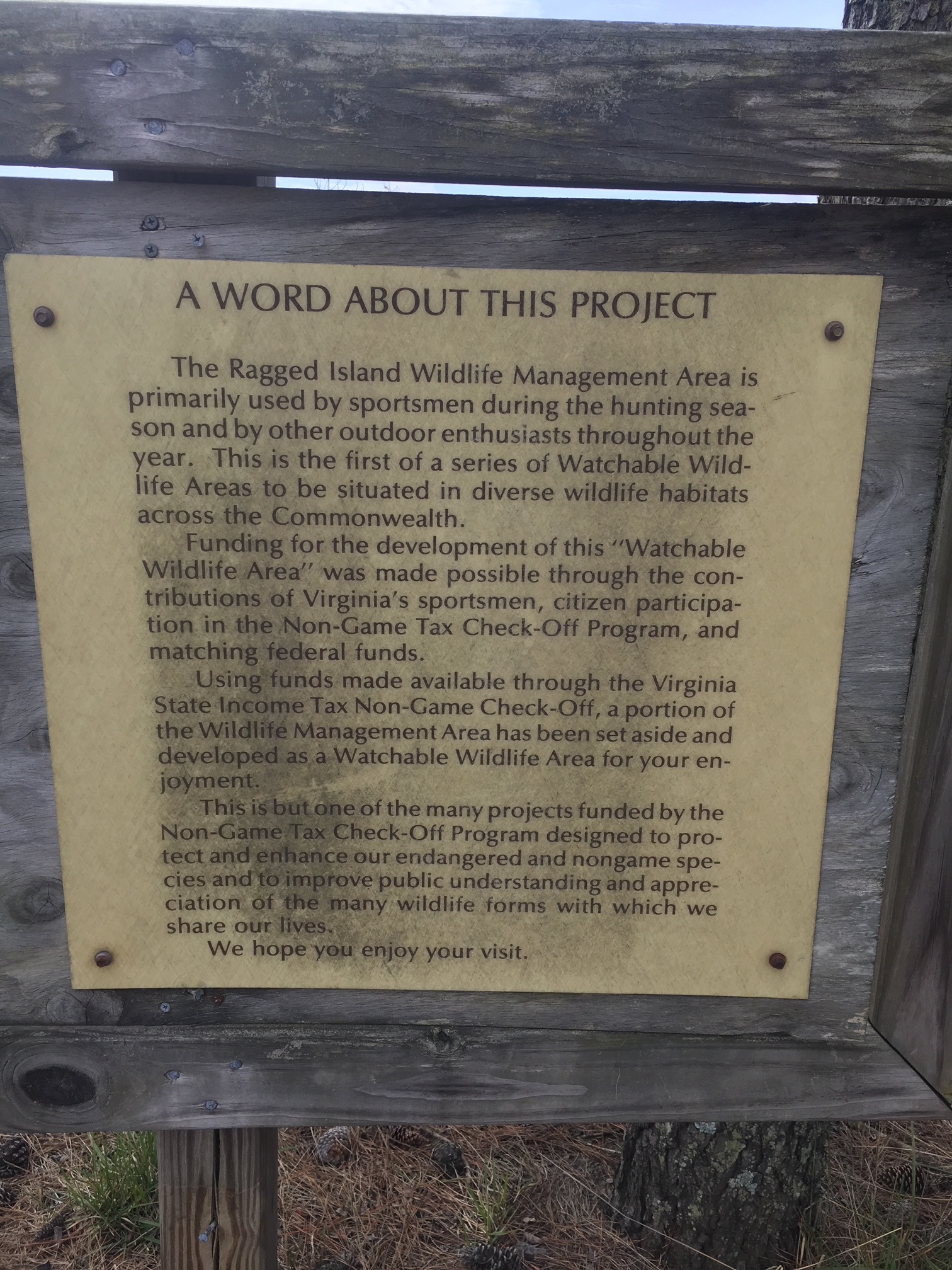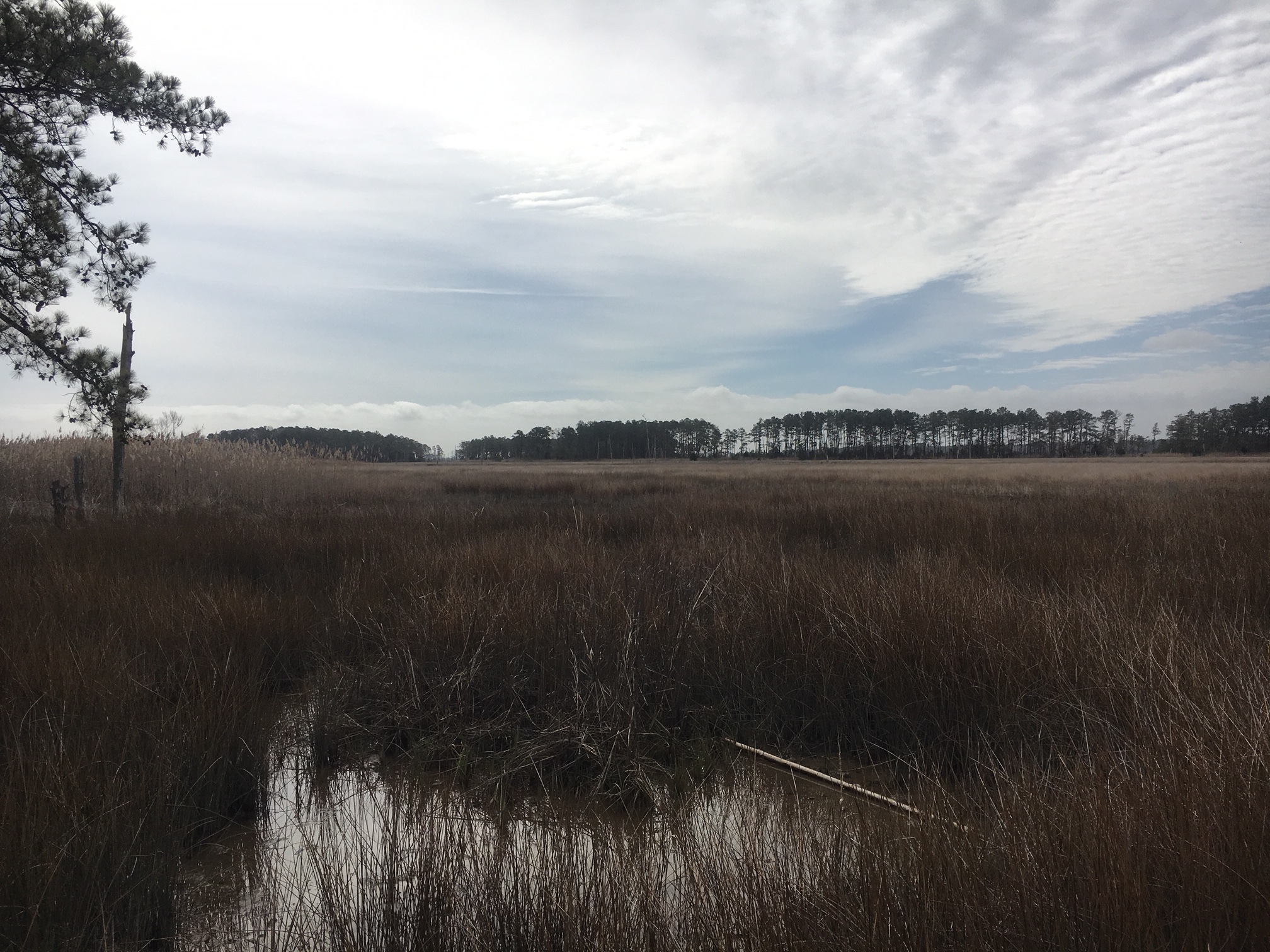Arguably the most prominent birding spot in Isle of Wight County, this WMA occupies over 1500 acres of mostly saltmarshes and tidal creeks, with scattered islands of loblolly pines. The property sits on the banks of the James River at the base of the James River Bridge (US 17), just minutes from downtown Newport News. As a huge tract of publicly accessible tidal saltmarsh, Ragged Island is known for being one of the most inland locations to reliable encounter saltmarsh species. It is also an excellent place to view the James at one of its widest points, just before it empties into Hampton Roads, which offers fantastic opportunities to see ducks, loons, grebes, and gulls during the winter months.
The main parking area for Ragged Island is a dirt lot about a quarter-mile west of the James River Bridge. This lot permits access to two trails; a short dirt path that proceeds straight east to a beach at the base of the bridge, and a longer path/boardwalk that passes through the marsh. The latter of these is of most interest to birders, as it passes through multiple habitats and offers the best chance at several specialty species. The parking lot itself is ringed with tall pines, as is the trailhead, and there is a second portion that passes through another island of pines just before the trail makes a sharp bend and heads out into the marsh. The trees are good for pine-loving species such as Brown-headed Nuthatch and Pine Warbler, but can also harbor flocks of migrating passerines in spring and fall. There is also plenty of brushy understory, particularly baccharis and wax myrtle, which is worth working for winter feeding flocks; in addition to Myrtle Warblers by the dozens or hundreds, one is likely to find both kinglets, and perhaps Orange-crowned Warbler or Fox Sparrow.
After the second pine island, the trail makes a sharp bend to the left and the dirt path is replaced by a wooden boardwalk. From this point, the trail begins to enter the marsh and birders should begin looking and listening for any of several saltmarsh specialties. Clapper Rails are probably the most common and conspicuous, frequently giving their guttural calls at almost any time of year or day, even if they are rarely seen. Virginia Rail and Sora have both been reported in fall and winter, though less frequently. There is also a record of Yellow Rail. Waders are sometimes around – Great Blue Heron and Great Egret are the most common species, but as herons and egrets disperse in later summer the diversity increases, and Snowy Egret, Tricolored Heron, Little Blue Heron, both night-herons, and White Ibis have all been reported. Marsh Wren is fairly common here and is reported with regularity even during the winter months, while Sedge Wren is scarcer but has been reported in fall, winter, and spring, and should be on birders’ radars. Perhaps the most sought-after species here are the marsh sparrows, and all three species occur. The most regular and easy to detect is Seaside Sparrow, which breeds here and can often been seen or heard from March through November. Nelson’s and Saltmarsh Sparrows are a bit trickier; they are usually only reported as migrants, with October accounting for the most reports of both. For marsh sparrows, arriving early in the morning can increase detections probability. Likewise, timing a visit with the tides is useful, as high tides can drive birds further up into the marsh and increase the chances of spotting them. A final species of note in the marshes is Boat-tailed Grackle – Ragged Island and the Smithfield meat packing plants are the only reliable locations for this species in Isle of Wight.
At the end of the boardwalk is an overlook that offers an excellent view of the James River. Scoping from this vantage point is particularly worthwhile in winter, when a variety of ducks including Bufflehead, Red-breasted Merganser, Surf Scoter, and occasionally both scaup, Canvasback, the other two scoters, and Common Goldeneye, are present. In addition to waterfowl, scanning here is also likely to turn up Horned Grebe, Common and Red-throated Loons, and perhaps something rarer like a Red-necked Grebe. Ring-billed, Herring, and Great Black Backed are the most numerous winter gulls, with Bonaparte’s turning up occasionally in migration and Laughing Gull becoming abundant by early March and through the breeding season. Outside the winter months, Royal Terns patrol the river all through the summer, while Caspian are present in spring and fall. Common and Least Tern, and Black Skimmer have all been reported here sporadically.
It is also possible to exit the boardwalk at the overlook and walk east along the beach. This is only possible at low tides, as the beach is essentially submerged at high tide. When the tide is out, there is a nice strip of sandy beach with some peat flats. Often there are no shorebirds around, but this could be a good spot for Sanderling, Dunlin, Ruddy Turnstone, American Oystercatcher, and perhaps even a Red Knot or Purple Sandpiper. If you walk the beach far enough to the east, you will eventually reach another, larger pine island that offers another shot at passerines.
Accessibility: As with all Wildlife Management Areas in Virginia, access is greatly limited during winter months when hunting takes place. Always check the DWR website for the most up-to-date information on access. Also, all WMAs in Virginia require an access permit, which for birders participating in the Virginia Breeding Bird Atlas can be acquired for free. Parking on the south side of US 17 can be accessed from both northbound and southbound lanes. The main boardwalk is handicap accessible.
Owner/Manager: Virginia Department of Wildlife Resources
eBird Hotspot: Ragged Island WMA
—Matt Anthony, April 2021



